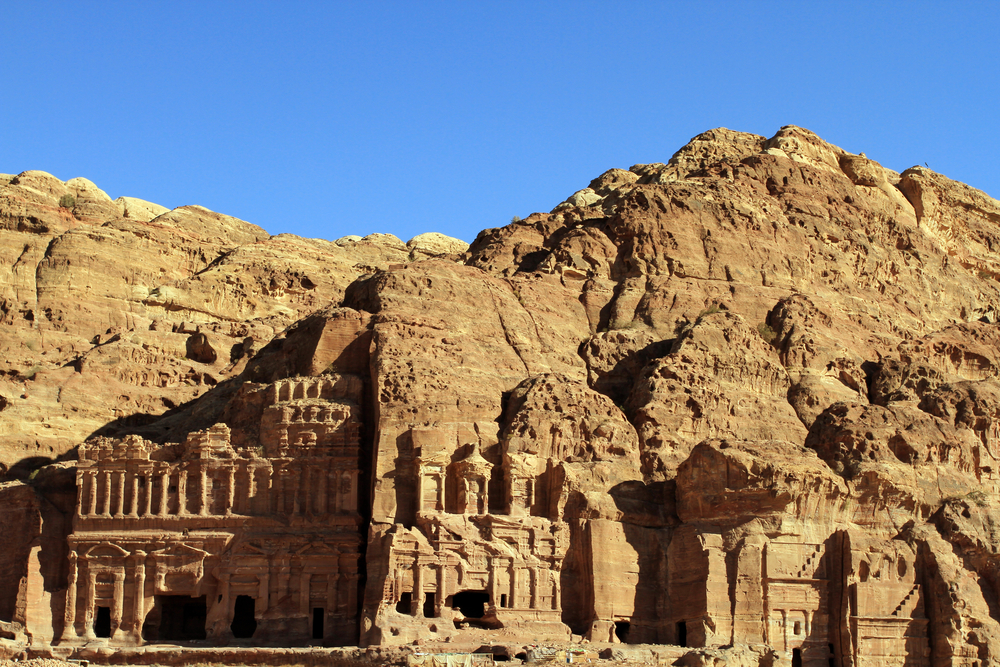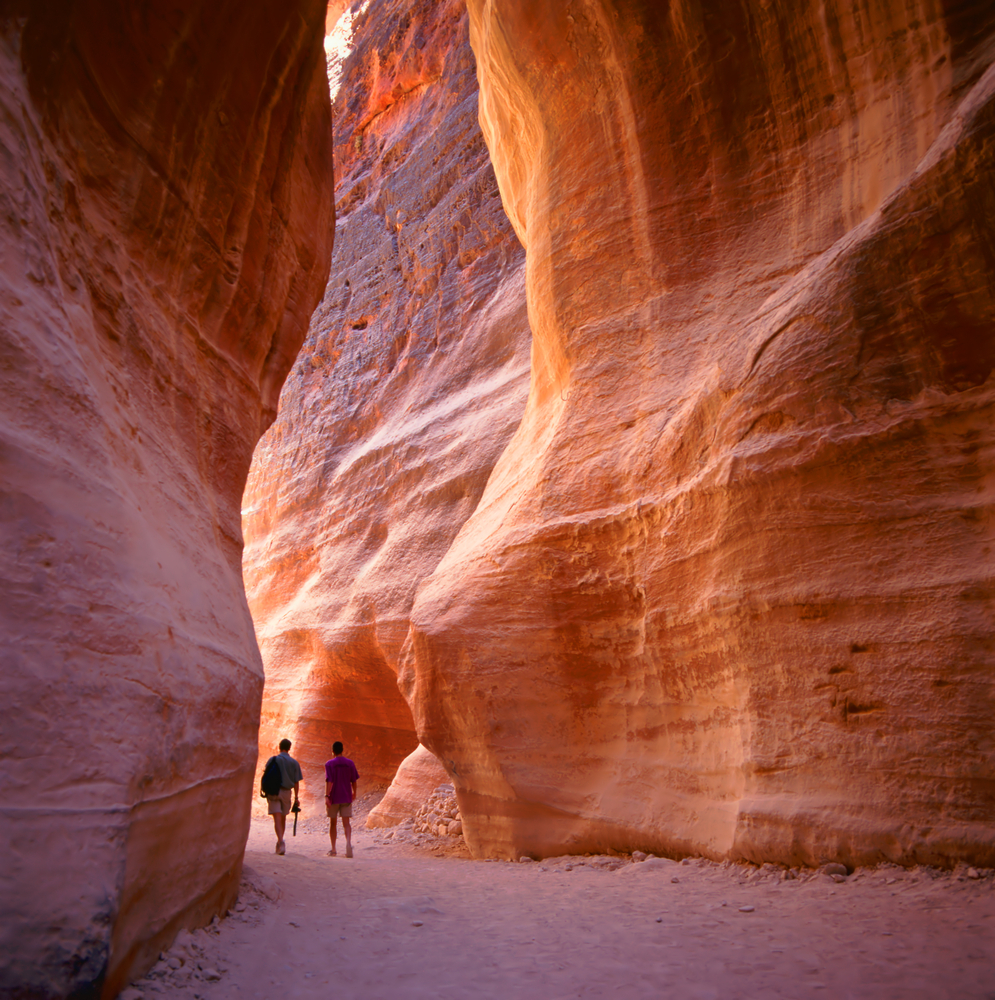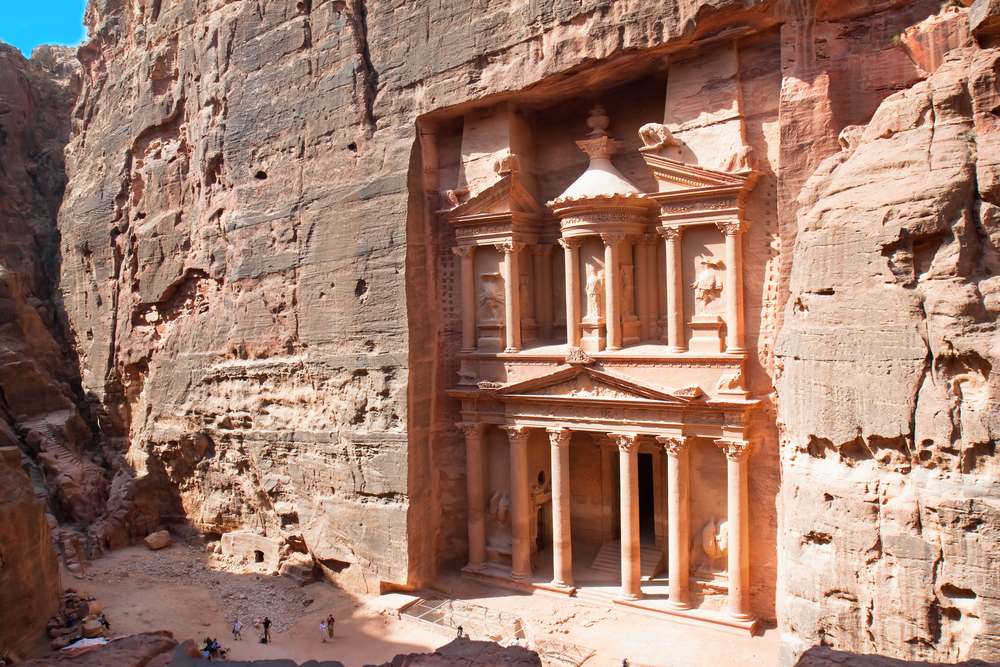Petra: Ancient City of Rock
Located about 115 miles (185 km) southwest of Amman, Jordan, Petra was an ancient city that was literally carved into red desert cliffs. Its ornate ancient architecture and natural beauty attract people from all over the world. Part of the film "Indiana Jones and the Last Crusade" was filmed in Petra, bringing it more popular attention.
Until its annexation by Rome in 106 A.D., Petra served as a capital for the Nabataeans, a people who wrote using an Aramaic language and controlled caravan trade throughout the region.
The earliest mention of these people is from 312 B.C., when they apparently withstood an assault by Antigonus, one of Alexander the Great's successors. In these early years the Nabataeans are believed to have lived a nomadic lifestyle, and Petra was likely a place of tents and simple structures.
This would change as the caravan trade developed, with Petra serving as a center of trade between Arabia, Mesopotamia, Egypt and the eastern Mediterranean. The city reached its peak about 2,000 years ago with a population estimated at 20,000 inhabitants.
In time, after the Roman annexation, the caravan trade petered out. Although the city was occupied in the Middle Ages, it was hit by a series of earthquakes and was eventually abandoned.
It was "rediscovered" by Johann Ludwig Burckhardt in 1812 and today it is a major tourist attraction. Contrary to the plot of the Indiana Jones movie, Petra is not located in a "Canyon of the Crescent Moon" and it is not the location of the Holy Grail.
Homes and water
Get the world’s most fascinating discoveries delivered straight to your inbox.
Analysis of housing remains at ez-Zantur, within Petra, suggests that people were building houses out of stone by 2,100 years ago, heralding a period of urbanization.
This process would see people abandon their tents for more permanent stone dwellings, in some instances carving them into the cliffs. In time freestanding homes for the elite would be created containing columns and multiple rooms.
Petra’s main street, referred to today as the colonnaded street, would be built on the south side of the Wadi Musa (a riverbed that sometimes has water). Walls would eventually be built on the north and south side of this wadi which, combined which Petra’s cliffs, made the city very hard to invade.
A sophisticated plumbing system would also be built with a system of channels, pipes and cisterns to bring water to the people. Archaeologists recently found evidence of this system during a geophysical survey of an area beside Petra’s main street.
All these developments, however, are today overshadowed by the design of the city’s tombs and temples.
The 'Treasury'
Petra contains numerous tombs, most of them built at the edge of the city, beyond the main street. Some were simple, containing multiple burials in an unadorned rock chamber, while others were more spectacular.
The best known tomb at Petra is called the “Khazneh,” which is Arabic for the “Treasury.” It is called this because at one time local people believed it contained hidden treasure. Today, archaeologists regard it as a two-story high tomb, albeit a masterful one. Its facade measures 82 feet (25 meters) wide and 128 feet (39 meters) high.
Mainly Greek in appearance, the columns are in a Corinthian style, the entrance flanked with reliefs depicting Castor and Pollux, a pair of mythical twin brothers. At top center is a draped woman who may be a version of Isis, the Egyptian goddess. Also depicted at top are six axe-wielding Amazons, mythical warrior women who were well-regarded in the ancient world.
Also shown are griffins, eagles, two winged creatures known as “victories” and depictions of natural vegetation such as poppies, grapes and pomegranates. Rosettes, a symbol of royalty, are also shown, indicating that this was the tomb of a king.
The interior of the tomb is relatively simple, containing a vestibule that branches off into three chambers, the largest one at center being 40 feet (12.5 meters) by 36 feet (11 meters) and about 32 feet (10 meters) in height. Three niches suggest that there were originally three sarcophagi.
There are no inscriptions, so it is not known who was buried in the tomb or when exactly it was built. King Aretas IV, who died in 15 A.D. and had two wives, is a candidate, notes researcher Andrew Stewart, in a section of the book "Petra Rediscovered" (Thames & Hudson, 2003).
Ancient temples
Petra’s ancient inhabitants maintained a rich spiritual life. Three temples located near the main street are believed to date to the city’s zenith, about 2,000 years ago.
One of them is known as the Qasr al-Bint (a short version of an Arabic name that translates “Castle of the Daughter of the Pharaoh”). Its walls are still preserved up to a height of 75 feet (23 meters). A person would walk up 19 stairs before coming to a landing, than another eight steps, past a series of four columns, to arrive at the temple vestibule, before passing into a main hall that is almost square at 91 feet (28 meters) on each side. The holy of holies, a room with a platform, was at the end. A relief at the temple suggests that the structure may have been dedicated to the god Dushara.
Another structure, known to archaeologists at the “Great Temple,” contains a small theater in a design similar to a modern-day orchestra hall. It was large enough to fit about 600 people with its outer layer of seats having a diameter of about 110 feet (33 meters). This theater may have been used for religious ceremonies. Among the temple decorations are depictions of elephant heads carved out of limestone.
A third temple, located partly up a hill, is the Temple of the Winged Lions, so named because depictions of winged felines were found near its altar. It contains an entryway and worship area with columns.
The temple itself is relatively small, about 82 feet (25 meters) by 60 feet (18 meters). However, as researcher Philip Hammond notes in the book "Petra Rediscovered," it has numerous support buildings, they "provided for housing of the temple personnel, pilgrims awaiting initiation into its rites, metal and oil fabrication areas, servicing facilities, and even for the production of religious artifacts for visiting tourists!”
— Owen Jarus, LiveScience Contributor
Further reading:

Owen Jarus is a regular contributor to Live Science who writes about archaeology and humans' past. He has also written for The Independent (UK), The Canadian Press (CP) and The Associated Press (AP), among others. Owen has a bachelor of arts degree from the University of Toronto and a journalism degree from Ryerson University.





